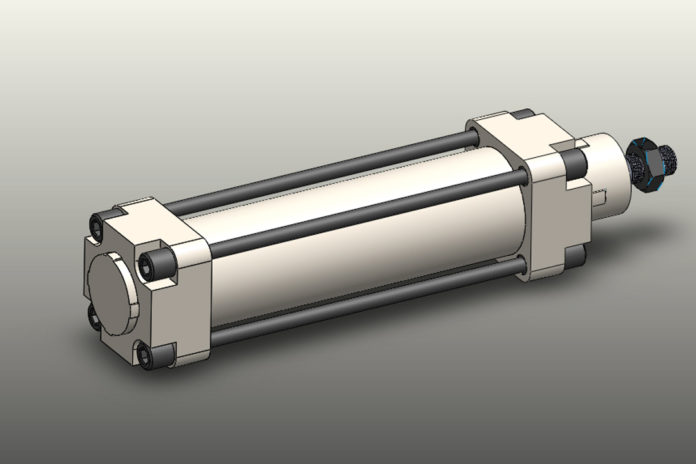What is an Actuator?
 The raw definition of an actuator is that it is a mechanism that puts something into automatic action.
The raw definition of an actuator is that it is a mechanism that puts something into automatic action.In our line of business, the actuators we commonly come across are rotary actuators which are used on lathes, however, actuators are not limited to lathes. I will focus on the rotary type that you will come across more frequently. The rotary actuator on a lathe is the device mounted on the back end of the spindle outside of the work area. It is responsible for the holding force which closes the jaws on the chuck which holds the part being machined by the lathe.
The rotary actuator is a hydraulic cylinder on which the center shaft can move back with hydraulic force as it holds that force while the inner shaft spins. The actuator does not spin on its own but is threaded onto the spindle drawtube of the lathe. When the spindle runs, the actuator shaft spins, while the outer housing of the actuator is held in a stationary position by a bracket which is usually mounted to the frame of the lathe. There will be typically three hose lines that run to the actuator. Two lines that handle the extend and retract movements, and one line for an oil drain path. The spindle shaft they connect to is commonly called the spindle draw tube and it goes through the center of the spindle and connects to the back of the chuck. The actuator extending and retracting action controls the jaws of the chuck of which the body of the chuck is mounted to the spindle. This motion causes the jaws to either move in or to move outward. The jaws are typically designed so you can move them in to clamp on the outside of a part, or to move them out to clamp a hollow part from the inside.
I mentioned a drain line earlier. This drain line is usually a larger clear inner braided hose so you can visually see the oil flow down and it typically runs to a drain port on your hydraulic system which controls the actuator. I mention that because there are many times when people call for hydraulic units but don’t need a hydraulic unit. They think they do because they may have a bad leak in the actuator. You see, the actuator is meant to allow some oil flow over the bearings to allow free movement at high speeds. This oil cools and lubricates the moving parts allowing the outside to be stationary while the inside can spin at 5,000 rpm, as an example. When you have seal failures in the actuator the oil trickle becomes a large flow of oil. When this occurs the pump may run hot or may lose holding force on the chuck as an example. So this will appear as a hydraulic unit failure but is not. You will need to advise them of what they should check first.
So when you have someone ask you about a hydraulic unit, because they think that they have a failure, you need to ask if it is a lathe and then ask if they checked to see if they have a large leakage from the actuator. If you don’t do this, and they put a new pump on that they bought from you and it does not work, then they will lose confidence in your knowledge of the products. So, always try to advise the customer and help them to learn from you. If you do this, then they will trust that you are knowledgeable and will feel more comfortable calling again to help them solve future problems that come up. Now you should have some idea of what a rotary actuator is on a lathe and how it pertains to you.
Written By: Darrell Janesak, Senior Technology Advisor
Please contact Darrell for more information at 1 (815) 943-9111
Tags
daikin
oil
hydraulics
awm
cnc
machine
lubrication
azbil
hydraulic
coolant
ehu
ecorich
sensors
repair
service
tool
pressure
application
pump
maintenance
tank
machine tool
grease
how to
cnc lathes
machinery
manual
parts
workholding
fixtures
custom
energy
pneumatic
technology
clamping
filter
mpa
psi
replace
fix
sut
motor
hpu
eco rich
iot
corepull
ClampMAX
HPU
Daikin
SUT
EcoRich
Eco Rich
Pallet
Clamping
Workholding
IFM
Clamp
Fixtures
IOT
Industry 4.0
Custom
Application
Solutions
flow
output
voltage
accessories
how to install
Hydraulic Units
Hydraulic Products and Systems
oil mist
proximity switches
machine rebuild
patlite
okamoto
grinder
grinders
titan
sales
rebuild
retrofit
spindle
engineering
technician
aerolap
nc
ca1
ca2
caiq
dx
dxnc
iq
ogm
ncag
udbx
uiii
unciiim chnc
chiq
igm
15nc
15nciii
2mb
gx
sa1
column
surface
type
cylindrical
double
id
rotary
saddle
linear
acc
upz
ball bar
laser
calibration
installation
extraction
tools
automotive
sporting good
healthcare
robots
agriculture
aluminum
magnesium
robotic
castings
forgings
bar stock
cells
tombstone
manifold
design
horizontal
vertical
cmm
inspection
customer
support
machining
process
axis
clamps
contract
chucks
live
tooling
iso
fastener
filtration
mesh
micron
element
canister
inline
head
direction
fluid
inlet
outlet
build up
plugged
replacment
suction
strainer
paper
media
discharge
return
water
rating
viscosity
spin on
line
indicator
pm
preventative
housing
stainless steel
wire
body
skimmer
tramp
overflow
absorbants
rags
belt
removal
bacteria
chips
fines
buildup
skim
clean
waste
hybrid
valve
chiller
cooler
troubleshoot
alarm
code
keypad
akz
akj
akw
akc
system
all world
heat
stock
noise
efficient
savings
adjustment
clampmax
pallet
ifm
clamp
industry 40
solutions
fixture
piston
fill
prime
power
lube
slr
progressive block
pdi
single line
resistance
positive displacement
injector
failure
replacement
lube usa
showa
graco
lincoln
daido
skf
vogel
taco
aryung
hansung
bijur delimon
greasing
greasing a bearing
mistakes to avoid
grease gun
grease syringe
grease application
SUT hydraulic unit
SUT Hybrid Power Units
EHU hydraulic unit
Eco-Rich EHU Hybrid Power Units
hydraulic power solution
multi-pallet system
panel builds
coolant mist
preventative maintenance check
Troubleshooting
Trochoid Pumps
Gerotor Pumps
usa machine rebuilders
refurbished machines
machine rebuilds
machines for sale
CKD
new website
instructions
miracle boy
ckd
welding
safety glass
machine retrofit
bohle flutemaster
newall troublshoot
signal tower monitoring
wd72
orings
pressure settings
energy efficiency
omron
marposs
metrol
nachi
bearings
limit switches
bando wiper edge
preventative maintenance
coolant pump
injection molding machines
oil chillers
oil chiller repair
linear motion guide
kyodo yushi
photoelectric sensors
daito
fuse
actuator
Show All
Posts
2024
March
2023
Unmatched Grinding Accuracy Plus Machine and Parts Availability
[03/27/24 08:54 AM]
Arrow Workholding Fixtures
[03/06/24 06:47 AM]
February
The Right Filtration for Your Machine Tool Application
[02/20/24 10:08 AM]
Oil Skimming Solutions for Machine Tools
[02/07/24 08:11 AM]
January
September
August
2022
ClampMAX Case Study for Industrial Bearing Manufacturer
[08/28/23 03:05 PM]
ClampMAX Case Study for Additive Manufacturer
[08/28/23 03:05 PM]
June
How to Prime a Piston Pump
[06/30/23 02:17 PM]
Choosing the Right Lubrication Pump
[06/30/23 02:17 PM]
May
October
2021
2020
How to: Install SUT Hydraulic Unit
[10/06/22 03:01 PM]
How to: Install EHU Hydraulic Unit
[10/06/22 03:01 PM]
September
ClampMAX Case Study for Multi-Pallet System
[09/02/22 12:06 PM]
Preventative Maintenance Check: Oil Mist
[09/02/22 09:09 AM]
August
March
December
November
October
2019
Patlite Product Highlights
[10/23/20 09:00 AM]
Product Spotlight: CKD Nitrogen Extraction Unit
[10/13/20 03:04 PM]
September
August
May
February
December
October
2018
IZUMI Friction Welding Machines
[10/29/19 10:00 AM]
AWM Machine Rebuild/Refurbishing/Retrofitting
[10/11/19 10:00 AM]
August
Eco-Rich Hybrid Hydraulic Unit (EHU & UEHU)
[08/26/19 10:00 AM]
[08/19/19 03:47 PM]
Machine Tool Safety Glass
[08/05/19 10:00 AM]
May
March
January
November
October
September
2017
2016
Troubleshooting Newall Digital Readout Systems
[09/25/18 10:00 AM]
Newall A50, C80, C70, DP700 Troubleshoot
[09/25/18 10:00 AM]
Lubrication: Grease vs. Oil
[09/25/18 10:00 AM]
Troubleshooting Daikin Oil Chillers
[09/10/18 10:00 AM]
Troubleshooting a Daikin EHU Eco-Rich Unit
[09/10/18 10:00 AM]
PATLITE Products
[09/04/18 10:00 AM]
August
PATLITE WD-Z2 Wireless Signal Tower Monitoring
[08/23/18 10:00 AM]
[08/13/18 10:00 AM]
Pressure Settings for EHU2507-40-N-903
[08/09/18 10:00 AM]
Pressure Settings for EHU3007-40-N-902
[08/09/18 10:00 AM]
July
Pressure Settings Procedure for UEHU25-M07-1530-V
[07/11/18 10:00 AM]
LHL Hybrid Lubrication System
[07/09/18 10:00 AM]
June
May
Sensors for CNC Lathes
[05/30/18 10:00 AM]
Customer Service Matters
[05/23/18 10:00 AM]
Daikin IOT Ready Hybrid Hydraulics
[05/21/18 10:00 AM]
Super Precision Ball Screw Bearings
[05/09/18 10:00 AM]
Azbil FL7M Proximity Switches
[05/08/18 10:00 AM]
Understanding the Functions of a Limit Switch
[05/08/18 10:00 AM]
April
March
[03/27/18 10:00 AM]
Hydraulics for Injection Molding Machines
[03/07/18 10:00 AM]
Oil Chiller Repair and Maintenance
[03/05/18 10:00 AM]
January



